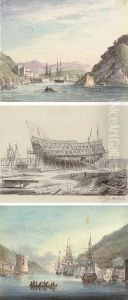Richard Lyde Hornbrook Paintings
Richard Lydekker Hornbrook was an Australian artist born in 1874 in Tasmania. Although not as widely recognized as some of his contemporaries, Hornbrook made significant contributions to the Australian art scene, particularly in the late 19th and early 20th centuries. His work primarily includes landscapes and maritime scenes, reflecting the natural beauty of Tasmania and other parts of Australia. Hornbrook's artistic journey began at a young age, influenced by the rugged Tasmanian landscape that surrounded him. He developed a keen interest in capturing the essence of the Australian environment, an interest that would define his artistic career.
Hornbrook's early work was marked by detailed observation and a naturalistic approach to painting. He was adept at using light and color to create atmospheric effects, which became a hallmark of his style. Over time, he experimented with various mediums but remained primarily focused on oil painting and watercolor. In addition to landscapes, Hornbrook also produced a number of portraits and still life paintings, though these are less well-known compared to his scenic compositions.
Throughout his career, Hornbrook participated in various exhibitions and was an active member of the Australian art community. He was associated with several art societies and contributed to the promotion of art education and appreciation within Tasmania and beyond. Despite his engagement with the art world, Hornbrook remained somewhat reclusive, preferring the solitude of his studio or the outdoors to the bustling art scene.
Richard Lydekker Hornbrook's legacy is preserved in a number of Australian public and private collections. Although he may not have achieved the fame of some of his peers, his work continues to be appreciated for its contribution to the depiction of Australia's landscape and natural heritage. Hornbrook passed away in 1952, leaving behind a body of work that remains a testament to his love for the Australian landscape and his skill as an artist.
